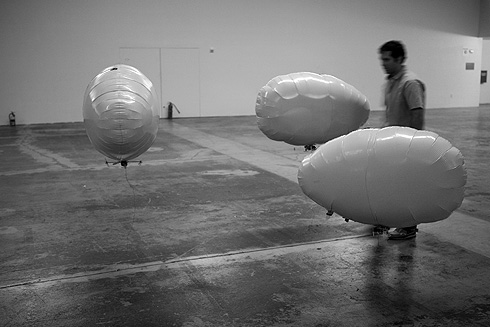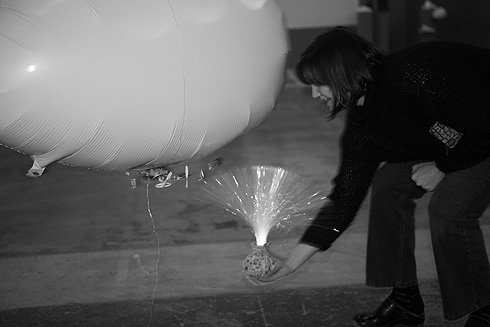SYSTEM OVERVIEW
1. ALAVs alone (autonomous)
![]()
They are autonomous and roam to feed or to seek other members of the flock. Eagerly anticipating interaction, they project a nervous shout when alone for too long. This behavior represents their collective awareness.
The ALAVs have an algorithm that defines how they roam in search of people or food. They are autonomous with respect to their decision making process; they determine their path by controlling directional motors. Sometimes one strays from the flock. However, if after two minutes an ALAV has not interacted with anything, it makes a noise. This call is made by a cell phone vibrator resonating on their helium envelope.

2. ALAVs with other ALAVs (flocking)
![]()
When not on the prowl for food, they constantly seek each other, yearning for attention. Within close proximity the ALAVs recognize another’s presence and commence a flocking behavior. The behavior consists of ALAVs (2 or 3) spinning together and calling back and fourth between each other. The flocking behavior remains active for 30 seconds or until the ALAVs drift apart. The coherence of the system represents flocking as both near and remote proximity, since an ALAV is aware of the rest of its flock even when not in close range.

3. ALAVs with a person (feeding)
![]()
The ALAVs interact with people by feeding when they come into close range of food. Their hunger level is indicated by their hanging LED. If it is blue, people can approach them with food and they will feed, But if it is red, they are full and will not respond when approached. The feeding is activated when a person holding the food approaches an ALAV. You get its attention when it stops its current behavior and flutters its motors (cycling through them twice). It will begin feeding for ten seconds as long as the food remains close.
Feeding is indicated by three synchronized cues. 1. The ALAVs blue LED blinks 2. The light on the food blinks 3. The food vibrates (simulating eating out of ones hand). An ALAV will get full after feeding for around 10 seconds provided the person with the food remains close. This is indicated by its red LED: it will remain on for 15 more seconds, until it has digested the food. To complete the cycle its blue LED will turn on and the ALAV can be fed again.

All materials contained therein are © copyright 2005-2006, Jed Berk + Nikhil Mitter